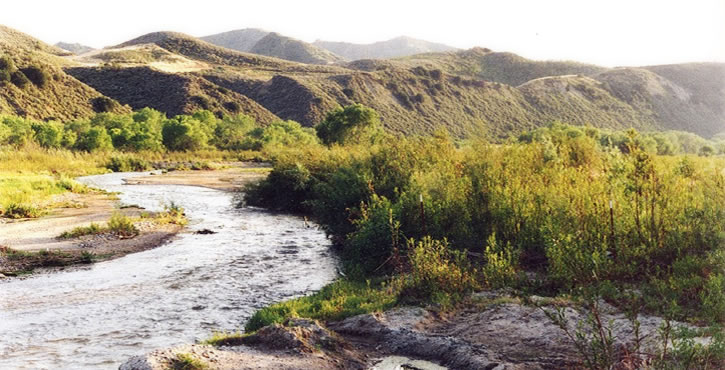
The Sierra Club’s Angeles Chapter joined five public-interest groups in April that are suing Los Angeles County over its approval of permits for the first phase of the sprawling Newhall Ranch development.
The proposed plan, one of the largest single residential development projects in California, would be sited on 12,000 acres of land along the Santa Clara River in northwest L.A. County. Newhall Ranch would create a city of more than 60,000 on a six-mile stretch of the river that is currently rugged open space and farmland by channeling the county’s last mostly free-flowing river.
Construction approved by the county on Feb. 23 would require filling the river’s floodplain on a large scale; channelizing more than three miles of river and converting many tributary streams to concrete-lined channels; unearth and desecrate Native American burial sites, sacred places and cultural natural resources such as the California condor; and threaten the San Fernando Valley spineflower, a species found in only one other location on the planet.
“It’s appalling that L.A. County would be so reckless with the last free-flowing river in the region,” said Ron Bottorff with the Friends of the Santa Clara River. “This area has lost all but 3% of its historic river woodlands; the county’s approval would replace some of the finest riparian areas remaining anywhere in Southern California with ugly strip malls and housing we don’t need.”
Why the river matters
The Santa Clara River is one of two major Southern California rivers remaining in a relatively natural state. It flows for about 116 miles from its headwaters on the north slope of the San Gabriel Mountains near Acton to its confluence with the Pacific Ocean between Oxnard and Ventura. Its watershed is home to a great diversity of very rare species, among them the unarmored three-spine stickleback fish, the California condor, least Bell’s vireo, Southwestern willow flycatcher, California redlegged frog, arroyo toad, Southern steelhead trout and San Fernando Valley spineflower. Wildlands of the Santa Clara River provides a full accounting of rare environmental resources of this precious landscape.
“The Sierra Club has fought throughout the nation and internationally for floodplain and river protection,” Angele Chapter Conservation Coordinator Jennifer Robinson said. “As part of this national focus, it is only fitting that the 40,000-member Angeles Chapter should continue its longstanding battle to protect Los Angeles County’s last free-flowing river, the Santa Clara River, with legal opposition to a project that will be built almost entirely in its floodplain.”
“Developing in a river floodplain is never a good idea,” said Ileene Anderson, biologist with the Center for Biological Diversity. “We should protect our precious water resources, not destroy them.” The suit was filed in Los Angeles Superior Court under the California Environmental Quality Act. Brought by the Center for Biological Diversity, the Sierra Club, Friends of the Santa Clara River, Santa Clarita Organization for Planning the Environment (SCOPE), and Wishtoyo Foundation and its Ventura
Coastkeeper program, the suit will ask the court to review the legality of the county’s approval process in order to protect this last remaining river resource area. L.A. County approved an overall plan for the Newhall Ranch development in 2003. After promising groundbreaking for the project in 2000, approval of this first phase some 12 years later is the first authorization permitting construction.
Follow the money
Plans have been slowed by the bankruptcy of LandSource Communities Development, the predecessor of Newhall Ranch’s current developer. CalPERS, California’s public pension fund, lost $970 million of state employees’ investment in Newhall Ranch with the LandSource bankruptcy. Now, with the infusion of cash and majority ownership by several out-of-state hedge funds, investors are again looking to move forward on this destructive and questionable proposal.
“Before a single house has been built, Newhall Ranch has already cost California’s taxpayers and workforce, including the county’s own staff, nearly a billion dollars of lost pension funds,” said Lynne Plambeck, president of the Santa Clarita Organization for Planning the Environment. “Although the state will never recover any of the largest single loss ever suffered by CalPERS, and will spend millions more in public monies to build roads, bridges and other infrastructure to serve this project, the county has once again endorsed this same development that will threaten the region’s water supply, worsen air pollution and cause further gridlock on our highways.”
“The project will impart irreversible impacts to the ecological integrity and water quality of the Santa Clara River watershed and Ventura’s coastal waters, harming the wellbeing of watershed residents and visitors for years to come,” said Jason Weiner, associate director and staff attorney for the Wishtoyo Foundation’s Ventura Coastkeeper Program. “The impacts to hundreds upon hundreds of our burial sites, and natural cultural resources such as the California condor that are such a vital component of our culture and religious practices, will be devastating and irreversible,” said Mati Waiya, a Chumash ceremonial elder and executive director of the Wishtoyo Foundation.